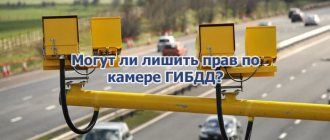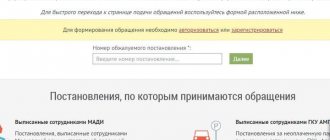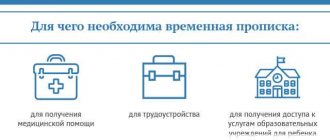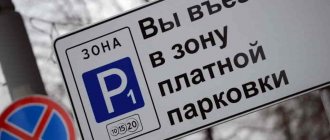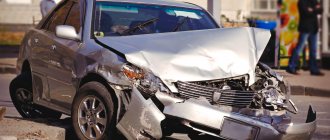AutoUrayt.rf / Questions
Back
Published: March 15, 2019
Reading time: 5 min
0
1154
Stopping a vehicle by a traffic police inspector is already an unpleasant situation that can throw the driver off balance. And conducting an inspection is a good reason for stress! How to behave? What laws to operate with? How is the procedure performed? To what extent do the powers of traffic police officers extend? These and many other issues will be addressed in the article, after reading which any driver will be able to protect his rights while acting within the law.
- The procedure for conducting a vehicle inspection by a traffic police officer
- The main differences between a search and a car inspection
- Grounds for inspection
- The procedure for stopping the vehicle
- Search for witnesses and release of the vehicle interior
- Direct inspection
- Drawing up a protocol
- Witnesses or video recording
- Inspector's responsibility
The procedure for conducting a vehicle inspection by a traffic police officer
All actions of traffic police officers performed in relation to drivers and vehicles are regulated by law. The main regulations that both parties - the driver and the inspector - can refer to in the event of a dispute include:
- Administrative regulations approved by Order of the Ministry of Internal Affairs of the Russian Federation No. 664 of August 23, 2017
- Code of Administrative Offenses of the Russian Federation
The search is also carried out in compliance with the articles of the listed laws . But it is possible that both parties to the procedure may interpret them in their own way, making mistakes and violations.
Inspectors rarely conduct inspections of vehicles, in most cases limiting themselves to checking documents. But drivers must be prepared for a different turn of events, which means they must know well how the search is carried out and how to protect their rights if an official openly exceeds his authority. After all, refusing or obstructing an inspection can entail serious consequences - arrest for up to 15 days (Part 1 of Article 19.9 of the Administrative Code).
Legal regulation
As of 2021, the procedure for conducting TPA is regulated by:
- Code of Administrative Offenses of the Russian Federation (Article 27.9).
- Order of the Ministry of Internal Affairs No. 664 of August 23, 2017.
Please note that Order No. 185 of the Ministry of Internal Affairs dated March 2, 2009 is not currently in force. Therefore, you cannot refer to it when protecting your rights.
Article 27.9 of the Code of Administrative Offenses of the Russian Federation is applied in cases where a person has committed an administrative offense, and in order to clarify the circumstances of the case, various types of searches are carried out, including cars. This rule applies in the event of an accident, as well as in the event of a driver violating traffic rules, etc.
The norms of Order No. 664 of the Ministry of Internal Affairs of the Russian Federation (hereinafter referred to as Order No. 664) must be observed by state traffic inspectors exercising federal supervision at stationary checkpoints and during patrols on the roads.
In accordance with clause 6.10 of Order No. 664, a traffic police officer has the right to require the driver to present the car for inspection only if there is reason to believe that there are weapons, drugs, psychotropic substances or other cargo in the car or in its trunk , prohibited from free circulation in the Russian Federation.
At the same time, the police officer must have facts to substantiate his suspicions.
There is no provision in the Code of Criminal Procedure of the Russian Federation allowing for an inspection of a car as part of a criminal case. In this case, a search is conducted to collect evidence.
The main differences between a search and a car inspection
Inspection or inspection? For most motorists, the differences in these concepts are insignificant or completely unnoticeable. But from the point of view of the law (Administrative Regulations approved by Order of the Ministry of Internal Affairs of the Russian Federation No. 664 dated August 23, 2017), the difference between them is significant. It's easier to track it in a table.
| Procedure name | Characteristic | |||||
| Formulation | Driver's consent | Exit from the passenger compartment for the driver and passengers | Examination of personal belongings in the car | Availability of grounds | Protocol | |
| Inspection | Visual examination of the vehicle without entering inside | + | — | — | — | — |
| Search | Actual content control | — | + | + | + | + |
In addition to the above wording of the actions of authorized persons when stopping a car, there is another one - “search” . The Law “On the Police” states that as part of these manipulations, the inspector can independently touch and move things inside the vehicle and violate its integrity . But the search is preceded by:
- Initiation of a case
- Issuance of the relevant resolution
If an inspector classifies his actions as an inspection, but independently opens the bags in the car, lifts the seats, opens the hood, and so on, then he violates Art. 27.9 of the Code of Administrative Offenses of the Russian Federation and may be punished with a fine of 20,000 rubles.
The difference between inspection and search of a car by a traffic police officer
Search and inspection are somewhat similar, but different procedures, differing in the degree of “depth” of analysis of the vehicle and its contents.
An inspection is a visual analysis of a car or other vehicle and the objects in it. With this procedure, the traffic police officer does not open the doors, does not violate the integrity; in fact, he only has the right to conduct a superficial inspection through the windows, using additional means such as a flashlight or other lighting source.
An inspection of the car can be carried out on the grounds listed in paragraph 197 of Order No. 664 of the Ministry of Internal Affairs. These include:
- information about a person committing illegal actions;
- checking vehicle data and existing documentation;
- discrepancy between the cargo and accompanying papers.
Car inspection is a more in-depth analysis of the car by a traffic police officer. The concept is given in Article 27.9 of the Code of Administrative Offenses of the Russian Federation. The grounds for inspecting a car are specified in paragraph 202 of Order No. 664 of the Ministry of Internal Affairs:
- verification of data on the presence of prohibited items in a car or other transport, for example, weapons or ammunition;
- verification of information about the presence of an instrument for committing an illegal act;
- detaining persons if there are grounds for such actions (Article 14 of the Law “On the Police”), for example, a citizen is wanted, has committed a crime, has created a danger to himself and others through his actions, has violated curfew rules.
The inspection is carried out with an orientation, that is, this is a primary, superficial procedure to obtain general information. An inspection is a more detailed check, during which it is prohibited to violate the integrity of vehicles and things, but you can study the contents in more depth.
The process for holding events is also different. For inspection, you do not need to draw up a protocol, invite witnesses or organize filming. An employee can simply “look” into the car and check his suspicions. Inspection of a vehicle by a traffic police officer requires more strict registration.
Grounds for inspection
This moment in the entire procedure raises the most questions. The main thing that the driver must remember is that the inspector’s words, not supported by documents, will not be grounds for inspection . This behavior is a direct violation of Art. 27.9 of the Code of Administrative Offenses of the Russian Federation and Order 664.
More on the topic: What to do if your car is taken to an impound lot?
The traffic police officer does not have the right to conduct an inspection at his own discretion . Legitimate reasons for checking a car will be:
- Availability of orientation for this vehicle
- Detention of persons in a car (Part 2 of Article 14 of Law 3-FZ of 02/07/2011 “On the Police”)
- Checking the information received about the participation of a car in a crime or offenses of various nature (information can be sent from traffic police posts, road users and more)
- Confirmation or refutation of data on the presence in the vehicle of objects with the help of which it is possible to commit an offense
- Checking information on the transportation of weapons, poisons and other dangerous substances
Previously, refusal to inspect a car became a reason for conducting a thorough search without the consent of the car owner. But in 2021, in the new reading of the regulations, such an item in the list of grounds does not exist.
Before starting the inspection, the driver has the right to check all the reasons given by the inspector by calling the duty station. The traffic police officer must provide the required telephone number.
If an authorized person deliberately detains the owner of a vehicle without carrying out the search procedure, despite notification of its beginning, the driver can immediately complain about unlawful actions by calling the duty station or any police department.
The reason for inspection cannot be the announced “Interception” plan. In peacetime, it only serves as a reason to stop the vehicle and check documents. But in wartime or in the event of martial law being introduced in the country, this is quite enough for a thorough inspection of any car.
Grounds for search requests
A sufficient reason for carrying out a traffic inspection is the identification by a traffic police officer of the fact that the driver has violated traffic rules, or the discovery, during a visual inspection of the car, of evidence of the driver or his passengers committing actions of an illegal nature.
For example, if during control procedures (visual inspection of the vehicle and documents) a police officer detected the smell of alcohol on the driver’s nose and recorded in accordance with the procedure established by law the fact that the driver was actually driving while intoxicated, then as part of drawing up a protocol on an administrative violation, the traffic police inspector has the right to inspect the car.
If, during a visual examination of the car interior, a police officer notices the presence of weapons or other prohibited items, then he must immediately ask everyone (driver and passengers) to get out of the car and can then begin the search procedure.
If there is no evidence that the driver or his passengers violated traffic rules or other regulations of the Russian Federation, then the policeman cannot demand access to the traffic police.
Moreover, any groundless search is a violation of human rights, for which the guilty police officer can be held accountable.
In accordance with Order No. 644, DTS is carried out with the mandatory drawing up of a protocol provided for in Article 27.9 of the Code of Administrative Offenses of the Russian Federation. Article 27.9 of the Code of Administrative Offenses of the Russian Federation is included in the section of the administrative code, which determines the procedure for ensuring proceedings for administrative offenses.
Accordingly, if a police officer insists on conducting a search without citing the fact that you or your passengers are suspected of committing any offense, then such actions by the security officer are illegal.
Procedure
According to the Administrative Regulations approved by Order of the Ministry of Internal Affairs of the Russian Federation No. 664 dated August 23, 2017 and the Code of Administrative Offenses of the Russian Federation, in the legal field the inspection procedure will look like this:
- Car stop
- Presentation of documentary grounds for stopping and searching
- Search for 2 witnesses
- Emptying the vehicle interior by the driver and passengers
- Thorough inspection of the vehicle by an inspector, including the trunk and cargo
- Drawing up a protocol on the procedure performed
- Signature left by both parties
- Transferring a copy of the protocol to the driver
It seems that everything is extremely simple and there should be no questions, let alone disputes regarding the inspection procedure. But in practice, both car owners and inspectors make mistakes during inspection. Therefore, some items from the above list will be discussed in more detail.
Vehicle stop
The traffic police officer on duty has every right to stop the car near the checkpoint and in any other place - in the city and beyond. At the same time, he can wave not only the wand, but also his hand. In both cases, the driver must stop.
More on the topic: Can traffic police officers record video with their personal camera?
The exception is situations when the inspector calls for stopping in places where this is prohibited by markings or road signs.
When the stop is made, the driver can calmly wait for the traffic police officer, who is obliged to:
- Introduce yourself verbally
- Provide reason for delay
The vehicle owner may request an inspector's certificate, which is provided upon request. Of greatest interest in the document are:
- Number
- FULL NAME. the official who made the stop
The listed data can be copied into a notepad. It is prohibited to photograph them .
Search for witnesses and release of the vehicle interior
The following cannot be witnesses:
- Passengers of a stopped car
- Traffic police officers
The inspector must appoint witnesses from random passers-by or stop another car for this purpose. Uninterested persons must provide the traffic police officer with identification cards, the data from which will be entered into the protocol.
Vehicle inspection is carried out only if the interior is empty . The driver and passengers are required to get out of the car, but be present during the procedure and facilitate its implementation within the legal framework. In this case, it is permissible to video and photograph the process.
Direct inspection
Here inspectors often exceed their powers. Therefore, any driver should know that:
- The official cannot touch personal belongings with his hands, open the trunk, hood and glove compartment - at his request, all such actions are performed by the owner of the vehicle
- Sealed cargo cannot be opened - it is reported by radio to the duty station and only after receiving the appropriate orders (this is done in the most extreme case, when there is a direct threat to life) the integrity of the seal is broken
- The squad officers do not prevent the driver from being near his car, but in case of suspicion that he has committed a criminal offense, they have the right to partially restrict his freedom (with handcuffs)
- If an administrative offense or other crime (committed or planned) is detected during the inspection, the inspector draws up a corresponding document.
In the first case, it will be a case of offense opened by the traffic police officer himself. In the second, a report is transmitted to the investigative team sent to the inspection site by calling the duty station.
Drawing up a protocol
Based on the results of the inspection, the authorized person draws up a protocol. It states:
- Inspector details: Full name, title, position
- Place and date
- Details of the person driving the vehicle: full name, date of birth, number and date of issue of driver’s license, place of registration, residential address, telephone
- Vehicle identification features
- Details of witnesses: full name, date of birth, place of registration, residential address, telephone
The protocol sets out in detail the procedure for conducting the search and the material evidence discovered during it (they must be photographed and printed out attached to the document) of the guilt of the vehicle owner in the criminal actions charged to him.
More on the topic: Is it possible to post videos of traffic police officers on the Internet?
The protocol must be handed over to the interested party for review. If he disagrees with any of the information presented, he has the right to refuse to sign the document.
Refusal to leave a signature must, according to the regulations, be reflected in the protocol. In any case, the driver receives a copy of the paper.
The procedure may be accompanied by the confiscation of any items from the owner. This fact and a list of things must be included in the protocol. If this is not done, the driver must point out the omission to the inspectors. Witnesses must also be present during the communication between the inspector and the person driving the vehicle.
Witnesses or video recording
It happens that the inspector refuses to look for witnesses, citing official video recording. Such actions cannot be classified as lawful. The law does not oblige traffic police officers to film the search. It is permissible to carry it out on their own initiative by both parties. But the presence of witnesses is a prerequisite for the legality of the search . Therefore, the driver must insist on their presence.
In a situation where the search is carried out in a deserted place and searching for witnesses is not possible, the driver must agree to official video recording.
Violations that traffic police officers may commit during an inspection
Some inspectors intentionally or unintentionally commit a number of violations during the procedure. Often they are left without recording by the driver, since he himself does not fully understand how exactly the inspection should take place.
The most common errors are:
- Lack of witnesses
- Removal of the vehicle owner from participation in the process
- Independently shifting things, which is already classified as a search
- Refusal to review the protocol
- Requirement to sign the protocol without prior review
- An order to put things out of the trunk
The second party to the inspection has the right to point out violations to the inspector in a polite manner and record it on video.
Inspector's responsibility
If a traffic police officer does not carry out the proper actions, but makes mistake after mistake, then there is no point in arguing with him. All violations can be recorded and included in a complaint within 10 days.
When considering it, officials will be guided by Article 19.1 of the Code of Administrative Offenses of the Russian Federation. If the complaint is confirmed, the inspector will be fined 20,000 rubles.
○ Legislative regulation of the actions of traffic police officers.
The inspection rules are regulated by Art. 27.9 of the Code of Administrative Offenses of the Russian Federation, as well as the Federal Law “On Police” dated 02/07/2011 No. 3-FZ.
An inspection of a vehicle of any kind, that is, an examination of a vehicle carried out without violating its structural integrity, is carried out in order to detect the instruments or objects of an administrative offense. (Clause 1 of Article 27.9 of the Code of Administrative Offenses of the Russian Federation).
The driver must be notified on what basis the inspector is going to inspect his vehicle.
Recommendations for the driver
In any situation, the road user is recommended to:
- Follow orders of traffic police officers
- Keep calm
- To be polite
- Take an active part in all manipulations performed with the car
- Capture what's happening on video
- Take contact details of witnesses and witnesses
Unpleasant situations often arise on the road. But the driver who knows his rights and does not break the law will be able to solve any problem within the legal framework.


